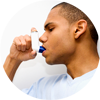COVID-19 Vaccine Administration: Your Questions, Answered
- How to decide between workplace and community vaccination
- How the two available vaccines differ, their effectiveness and safety
- Tools to overcome vaccine hesitancy among employees
- Seven supply chain challenges to effective vaccine distribution
Presented by:
Jeffrey Wainstein, MD, vice president of medical operations
Opening
0:02-0:54Dr. Jeffrey Wainstein will be presenting the Concentra webinar, What Employers Need to Know About COVID-19 Vaccine Administration. Dr. Wainstein is the vice president of medical operations for Concentra. He has more than 30 years of experience in health care and is board certified in emergency medicine. Dr. Wainstein is skilled in developing medical program strategy for onsite initiatives, such as onsite vaccine administration. At the conclusion of the presentation we will have a 10-to-15-minute QandA session with Dr. Wainstein. You can submit your questions throughout the presentation to be answered during the QandA. Dr. Wainstein will answer as many questions as possible within the time allowed. He will answer as many questions as possible within the time allowed. A recording of the webinar and the slides will also be emailed to you after the presentation. You can view them again at your convenience.
Dr. Wainstein, we're ready to begin.
What employers need to know about COVID-19 vaccine administration
0:56-1:58
Welcome, everyone. Thank you for joining us today. We have a lot of information for you. But before we begin....
I want everyone to think back to February 10, 2020, which is one year ago. At that time, the world reached a milestone. That’s when the deaths from the SARS Cov2 virus, which causes COVID-19, reached 900 deaths worldwide and surpassed the death toll of the previous SARS epidemic in 2003.
Now, today, one year later, on February 10, 2021, we’re close to 500,000 deaths in the United States alone with more than 27 million cases reported since the beginning of the pandemic. But we do have new hope: two COVID-19 vaccines are currently available in the United States with more on the way.
In this webinar, we’ll talk about the new vaccines and provide some insights to help you and your workforce navigate the nation’s ambitious COVID-19 vaccination plan.
Agenda
2:00-2:42
Here is our agenda. We’ll begin with a discussion of the vaccine distribution process and the magnitude of the challenge we face.
Next, we’ll turn our attention to the vaccines themselves and some important clinical considerations you should be aware of as you make decisions for getting your workforce and yourselves vaccinated. We’ll look at some key points you need to think about in preparing a COVID-19 vaccination policy and communicating the need for getting the vaccine to your employees.
Finally, we’ll address the big question: When can we remove masks, feel safe and get back to normal?
At the conclusion of the webinar, we will take your questions. So, let’s begin.
Challenge for a nation and for employers
2:43-3:17
Strategies for employers to get their workforce vaccinated include:
- Partnering with a health care provider to hold an episodic vaccine clinic at the workplace
- Offering vaccinations at an employer-based onsite health center for those who have such a facility, or
- By using community vaccination sites, where they are established
In this webinar, we will look at the approaches you can take and the challenges of each.
But, first, let’s get an overview of the scope of the national challenge in distributing the COVID-19 vaccines.
The largest product launch in the history of mankind
3:18-5:10
For the past year, the race was on to get a vaccine, and the vaccines have been developed in record time. To put this in perspective, vaccines have an average go-to-market time of eight to ten years. Prior to the COVID-19 vaccines, the quickest a vaccine has come to market was the mumps vaccine, and it took four years. So, now that we have the vaccine in record time, the challenge is to get it to:
- The high-risk population: health care workers, people in long-term care facilities, the elderly, and those who have high-risk, comorbid conditions
- Other essential workers
- And, eventually to all of us
The sheer scale of vaccinating the world is daunting. With most vaccines in development requiring two doses for full effect, there will be a need for roughly 15 billion doses worldwide to get the immunization we’re looking for.
A logistics leader has called COVID-19 vaccine distribution “the largest product launch in the history of mankind.”
Rapid mass immunization has proven challenging for many reasons, including:
- Storage and shipping requirements for the vaccines
- Recommendations for two shots within weeks of each other
- Insufficient governmental and public health policies and infrastructure to deliver vaccines efficiently and equitably
- Vaccine hesitancy
- Political barriers to sharing vaccines internationally
- Ongoing virus transmission; and
- A shifting sea of coronavirus mutations
We need to continually adopt new strategies to surmount these challenges and keep hope alive. As someone has said: Even on a good day, the response to this shifting pandemic is like building an airplane in flight.
Seven supply chain challenges
5:11-7:18
In an article from the Poole College of Management, potential supply chain bottlenecks were identified through computer modeling. Key concerns include:
- Supply chain personnel shortages. Not all supply chain personnel are in the higher priority vaccination phases. COVID-19 outbreaks in these businesses could shut down the entire supply chain.
- Lack of coordination. Some of you might already be feeling this. Each state and some local jurisdictions have set up different rules for who gets the vaccine first and how the vaccines are going to be distributed. The lack of a centralized registration system in many areas has set off a scramble for doses.
- There are potential materials shortages. It’s not just the vaccine we need, but things like glass vials and rubber stoppers for vials. Nurses giving the vaccine need alcohol wipes, syringes, needles, masks and gloves – some of which are in short supply in places.
- Limited fill-finish capacity or the ability to take the liquid vaccine and put it into vials that can be distributed. Each vial carries a limited number of doses.
- Vaccine handling requirements and potential damage to the vaccine are other challenges. The Pfizer vaccine requires ultra-cold temperatures. We will be talking about this. The Moderna requires freezer temperatures during transportation and storage. So, refrigerator and freezer trucks are needed for movement of the vaccines, and these aren’t in huge supply. Specialized freezers are required to store the Pfizer vaccine, and they are not widely available.
- There are also concerning gaps in rural areas where residents already have limited access to health care. Difficulties transporting and storing the vaccine may be greater.
- And finally, last but not least, misinformation. While not specifically a distribution or supply chain issue, debunking misinformation about the COVID-19 vaccines themselves is necessary for the success of the overall effort.
Communicating with employees about COVID-19 vaccination
7:19-8:57
Vaccinating as many people as possible, as quickly as possible, is vital to containing virus spread and returning business back to normal. Surveys, like this one from the Kaiser Family Foundation, show that “vaccine hesitancy” or reluctance to get vaccinated, is higher than we see with the seasonal flu vaccine or other vaccines. Nationwide, 35 percent of respondents believe the risks of COVID-19 have been exaggerated. The problem is even worse in rural areas where up to 40 percent are not even worried about getting sick. A study by the Institute for Health Metrics and Evaluation showed only 52 percent of Americans are willing to get the vaccine. But, to reach adequate levels of immunity in the population, or what we call herd immunity, it is projected that we need more than 80 percent of Americans to get vaccinated. So, we have some work to do.
Whether you mandate the vaccine or make it voluntary at your workplace, you do have an opportunity to effectively communicate to your workforce your concern for their health and the safety of the workplace, and to help dispel the myths around COVID-19 vaccination. Our hope is that the information presented to you today will help your ability to do just that. At the end of this presentation, we will share some resources with you, including a CDC toolkit, that will help with your communication efforts. I do encourage you to explain the facts to your employees. Don’t avoid the conversation. We know you’re probably having the conversations right now. We know it’s on everybody’s mind.
Five questions employees commonly ask
8:58-10:40
Let’s look at some of the top questions employees are asking.
One question we frequently see – not just with the COVID-19 vaccine but others including the seasonal flu vaccine – is: Will the vaccine give me COVID-19? The answer is clearly NO. Neither Pfizer nor Moderna contains live virus, and it is not possible to get the disease from the vaccine. Both vaccines, however, do have some side effects that may mimic the disease, such as the development of fever in the day or two after receiving the vaccine, which may be misinterpreted as getting the illness itself.
Second question: Are they safe? I want to assure everyone on the call that both vaccines have an Emergency Use Authorization from the FDA and have been shown to meet rigorous safety criteria in clinical trials this past year that were testing for both effectiveness of the vaccine as well as safety.
Many times, people will say they are very healthy and don’t need a vaccine. But we have seen that even young and healthy people can get seriously ill with COVID-19 and, even if they don’t get sick, they still pose a risk to spread the virus to more vulnerable people in their family, their community, and in the workplace.
If someone has already contracted COVID 19, we don’t yet know how long their immunity will last or, for that matter, how long the immunity will last after getting immunized. Further studies are being done to answer these questions.
So, even if someone has already had COVID-19, it is recommended that they get vaccinated to prevent a recurrence.
How long will it take? Vaccine administration scope and hurdles
10:45-12:37
So, where are we in this rollout process?
The first dose of vaccine was given on December 14, 2020. As of February 9, 2021, there were nearly 63 million doses that have been distributed by the federal government and more than 43 million doses have been administered. That results in a gap of about 20 million doses that are still sitting out there between those that are delivered and administered, which is about consistent with what we’ve been seeing through that process. The counts on this slide represent doses, not people. Each person requires two doses.
The Biden administration had set the goal of 100 million doses to be administered in the first 100 days, or one million doses per day. This initial goal has been increased to 1.5 million doses per day, which we have nearly achieved. The current average rate of vaccine administration in the last week is just under 1.5 million at 1.49 million doses per day in the United States.
Currently, about 9.9 percent of the population has received one dose, so they’re partially immunized. About three percent of the population has been fully immunized, having received two doses. Remember, the goal is to immunize at least 80 percent of the population so we have a ways to go.
You can stay informed of vaccine distribution tallies, if you are interested, by clicking this CDC link. The CDC reports the number of vaccine doses distributed and administered and updates the numbers daily. The figures on the slide are for yesterday, February 9th. The CDC page also contains other good information as well if you’re interested.
How the CDC manages vaccine administration
12:40-14:00
Now that we have a sense of the challenge before us and where we are in the effort, I’d like to talk about the process in place. Currently, the federal government acquires the vaccines and distributes them to the states. Breaking news reports that the federal government will start shipping vaccines directly to community health centers next week. They have not done this before. This is an effort to speed vaccinations and ensure doses are reaching vulnerable people, bypassing the state governments. The federal government will ship doses to 250 centers nationwide that were selected based on their proximity to vulnerable groups, such as homeless people and those with limited proficiency in English. Things keep changing from week to week.
The CDC has created recommendations, guidelines, tools and resources to help with the effort so let’s take a look at what they are doing.
- And we will look at some key points of the new Administration’s COVID-19 vaccination plan.
- Finally, in this section, we will look at some of the institutional tools the CDC uses to track vaccine distribution and to monitor vaccine safety.
ACIP Recommendations on allocation, Moderna and Pfizer vaccines
14:04-15:49
At the end of 2020, the Advisory Committee on Immunization Practices, or ACIP, issued recommendations for allocation of the two vaccines. You are probably very familiar with the phases identified and recommended by ACIP.
They prioritized health care workers and long-term care facility residents first in Phase 1A, followed by other frontline essential employees and people 75 and older in Phase 1b, estimated at about 49 million people. Next were adults age 65 to 74, anyone with high-risk conditions and all other essential workers in Phase 1c, estimated at 129 million people.
This was followed, in Phase 2, by everyone else.
These are just guidelines. States and counties are not only modifying these priorities but have different definitions of essential workers. They also may be in different phases of distribution, depending upon availability of vaccine in their state or area. Again, this is causing uncertainty and some level of confusion.
At this time, at least 43 states have expanded their occupational-based vaccines to include some non-medical essential workers, like police officers and grocery store workers, in addition to health care providers.
The path ahead: Biden Administration plans
15:52-17:52
While the goal set by the new administration is 1.5 million vaccines per day, most experts think this number is too low and needs to be closer to three million doses per day, double what we’re currently at. At the current pace, only about half of the total population would be at least partially vaccinated by mid-July, and we likely wouldn’t reach our ultimate goal until late November. None of us wants to wait this long.
The administration now says there will be enough vaccine by summer’s end for 300 million people.
In the administration’s new plan, the priority groups will remain the same. Proposals intended to maximize the rate of immunizations include the establishment of 100 FEMA vaccination sites, mobile vaccination clinics and invoking the Defense Production Act to expand vaccine supplies and production.
On January 29, OSHA issued employer guidance. While there are no new legal requirements, this guidance highlights five essentials to prevent transmission of COVID-19 in the workplace. I hope you are all familiar with these. OSHA recommends that all employers take the following actions, many of which you probably already have done.
These are:
- Conduct a hazard assessment in the workplace.
- Identify control measures to limit the spread of the virus.
- Adopt policies that don’t punish employees for missing work due to isolation or quarantine requirements, helping to reduce barriers for potentially infected employees to stay home.
- Ensure COVID-19 policies are communicated in the employee’s language.
- Implement protections from retaliation for employees who raise COVID-19 concerns.
The Vaccine Tracking System (VTrckS)
18:00-19:27
There is a mechanism in place to track where vaccines are going and to monitor safety, including tracking all adverse reactions. The Vaccine Tracking System, or VTrckS, you may have heard of it, was completed in 2013 and has been in use since then. It is a web-based vaccine order-management system from the CDC.
VTrckS is currently being used for almost 80 million doses of various vaccines given each year. It tracks the vaccines allocated, distributed, administered, monitored, and reported. For COVID-19, it allows the 64 state, local, and territorial public health jurisdictions, the federal agencies receiving direct COVID-19 vaccine allocations, including the Department of Veterans Affairs, Department of Defense, Department of State, Indian Health Service, and Bureau of Prisons, and enrolled national provider organizations, such as pharmacy chains, to:
- View vaccine allocations allotted to each program.
- Place and manage vaccine orders from their providers.
Once the orders are received, the federal government then authorizes the order through the system and sends the order to the manufacturer, who then ships the vaccine directly to the provider.
The system then allows for tracking vaccine shipments and generates reports through the whole process.
Three tools for vaccine administration compliance and symptom tracking
19:28-20:28
The CDC also offers three other tools that I just want to mention briefly. They are for recipients of vaccines to help ensure dose compliance and to ease concerns about vaccine safety or side effects.
- The first one is VaxText℠ which provides a second dose text message reminder to vaccine recipients and follows up on post-vaccination health.
- The second is V-safe After-Vaccination Health Checker. This is a tool to report side effects, also text message-based and quite easy to use.
- And the third one is VaccineFinder, which is a website used to identify available vaccination sites for the general public. Although this one isn’t currently in use for COVID-19 vaccines. It is in use for other vaccines. It should be used for COVID vaccines once the vaccines become more widely available.
Vaccines available today
20:30-21:12
I’ve mentioned the two vaccines available today that have received emergency authorization in the United States: Pfizer and Moderna. Both are mRNA vaccines and, as I said earlier, and I want to reinforce, neither contains live virus. There are 65 other vaccines currently in clinical trials, 10 of which are presently being used in other countries. There are several others in late-Phase 3 trials that are close to receiving emergency authorization. But today, we will be focusing on the two vaccines that are currently available in the United States.
Pfizer-BioNTech
21:17-22:29
Key points about the Pfizer vaccine are:
- It has super-cold storage requirements which can be maintained in two ways:
- Either by keeping the vaccine in the shipping container that comes packed with dry ice and replacing the dry ice every five days for up to 30 days or
- By using specialized freezers that are able to chill the vaccine to below minus-76 degrees Fahrenheit. Normal freezers don’t get this cold.
- Adverse reactions are common and anticipated, and we will talk more about those in a few minutes. Serious adverse reactions are rare, and most side effects resolve quickly.
- It requires two doses, which are given 21 days apart.
- Each vial contains five to six doses of 0.3 mL.
- This vaccine is authorized for adults 16 years of age and above. Currently, there are no COVID-19 vaccines approved for children.
Moderna
22:31-23:10
Key points about the Moderna vaccine are:
- The transportation and storage requirements are easier to meet than with the Pfizer vaccine. The temperature requirements are in normal freezer and refrigerator temperature ranges.
- Like with Pfizer, adverse reactions are common and anticipated but serious adverse reactions are rare. Most side effects resolve quickly.
- It also requires two doses, which are given 28 days apart.
- Each vial contains 10 doses of 0.5 mL, as opposed to five or six for Pfizer.
- This vaccine is authorized for adults 18 years old and above.
Comparison of the first two available vaccines: Moderna and Pfizer
23:13-24:35
Let’s compare them in four areas: effectiveness, storage temperatures, preparation and doses per vial.
Effectiveness. Both vaccines require two doses, and second-dose compliance is critical. Moderna is 80.2 percent effective after the first dose, compared to 52 percent for Pfizer. But both reach about 95 percent effectiveness two weeks after receiving the second dose.
Storage. Moderna is much easier to handle and store while the Pfizer vaccine must be stored at much colder temperatures, requiring special industrial freezers.
Preparation. Both vaccines need to be thawed to room temperature prior to administration. Moderna comes ready to administer where the Pfizer vaccine must be diluted before it is given, causing a little more difficulty or complexity with the Pfizer vaccine.
Doses per vial. A Moderna vial has 10 doses of 0.5 mL. A Pfizer vial contains five to six doses of 0.3 mL.
Dosing and administration recommendations summary
24:38-25:56
Both vaccines require two doses to be effective.
The timing that is recommended for the second dose is 21 days after the first dose for Pfizer and 28 days after first dose for Moderna.
But the second dose of either vaccine may be given up to four days early, if necessary, and can be given later than the recommended time interval. It is not required to repeat the series if there is a delay in receiving the second dose, whether due to vaccine shortages or other barriers that an individual might encounter. There is even some evidence to suggest that the second dose may actually be more effective when it’s delayed, so this is being studied. The recommendations currently are based on the original clinical trials.
It is recommended that the second dose be the same vaccine as the first dose. But there is a current study being done to address the impact of using different vaccines for the first and second doses, in addition to examining the efficacy of different time intervals between the vaccine injections. So, these recommendations may change, depending on what we learn from these new trials.
Possible post-vaccination side effects
25:59-28:06
Every vaccine has side effects and the clinical trials have shown that these vaccines are no exception. The side effects of these vaccines are common, expected, generally mild and indicate that the immune system in the body is working the way it should. It’s responding to the vaccine.
- We’ve seen that almost 90 percent of vaccine recipients experienced one or more local reactions, such as pain, redness, or swelling at the injection site or swollen lymph nodes.
- Up to 83 percent experienced one or more systemic reactions, such as fever, fatigue, muscle aches, headaches, nausea/vomiting, or chills.
Most of the systemic reactions are mild, occur within two to three days of vaccination, with most occurring the next day. They do seem to resolve fairly quickly, within one to two days of onset, and are more frequent and severe following the second dose and more prevalent among younger people compared to people 55 and older.
Some people may experience side effects so severe that it might prevent them from being able to work. To minimize the impact of these side effects on business continuity and staffing, considerations for employers include:
- Vaccinating individuals preceding one or two already scheduled days off
- Staggering the delivery of the vaccine to your workforce (meaning...not vaccinating everyone in one area or the same job duty at the same time)
- And providing information to the workforce on the potential for side effects so they are aware and anticipate them
Because some of the side effects, such as fever, may mimic an acute infection, there are times that it may be difficult to delineate the two. Strict isolation, clinical evaluation and COVID-19 testing may be warranted for some individuals with severe side effects to rule out the possibility of an acute COVID-19 infection.
Possible post-vaccination side effects and contraindications
28:08-28:57
A very small number of people may have a severe allergic reaction or anaphylaxis to the vaccine. For Pfizer, we have seen a rate of about 11 such reactions per one million doses administered and about 2.5 cases per one million doses with the Moderna vaccine.
This side effect is rare but can be life-threatening and is the reason for the mandatory 15-to-30-minute observation period after receiving either vaccine.
Some people with a known history of a severe allergic reaction to any of the ingredients in the vaccine should not receive it, and all recipients are screened using a questionnaire prior to receiving the vaccine.
Creating a COVID-19 vaccination policy
29:02-29:30
As you take in all this information, I think the need for your business to have a well-articulated vaccination policy becomes clearer. Over the last year, the pandemic has created stress and anxiety in many of us – conditions that reduce our ability to listen and reason calmly. This is why the communication of facts, maybe multiple times, is necessary.
29:31-30:48
So, what should your vaccination policy contain? You can see the four critical points here:
- First, decide whether you are going to mandate the vaccine or make it voluntary. The EEOC has determined that employers can mandate that their employees get the vaccine. If you decide for your organization that getting the vaccine is voluntary, you should consider offering some type of incentive to encourage compliance. The more compliance you can get, the better it will be for your organization and the quicker we can get back to normal.
- A survey released last month by a human capital research firm found that almost 40 percent of businesses have decided to make COVID-19 vaccination voluntary – but with strong encouragement to get vaccinated. Another 40 percent are still deciding.
- Of course, you should consult with your in-house experts: Human Resources, Safety, Legal counsel, and Operations.
- Communicate the policy to your employees, and
- Invite discussion. This should always be friendly, never adversarial
One decision and related considerations for employers
30:50-32:55
Let’s get to a question all employers need to consider –
The question is: How are you going to get your workforce vaccinated?
Are you going to arrange for an on-site event for COVID-19 vaccine administration
or
Are you going to send your employees into the community to get vaccinated?
Some large employers have their own onsite health centers and are coordinating vaccine administration through the established onsite. Many large employers without an onsite health center are already planning to hire a provider to run an episodic on-site vaccine event.
For employers who want an on-site event, the provider you choose to partner with to administer the vaccine must apply to the state to be eligible to administer the vaccine. There are the vaccine storage considerations we have discussed that need to be addressed, as well as space considerations to maintain social distancing during the event. An on-site event may require specific equipment and supplies, such as an on-site freezer capable of reaching very cold temperatures, dry ice, specialized temperature monitor gauges, and trained medical personnel in the proper handling and administration of the vaccine and the management of adverse side effects. There are many providers that have experience in providing workplace vaccine events but given the breadth and scope of this vaccination effort, it may be difficult to secure a provider that is available to perform this service at your workplace.
The benefits of having an on-site event are clear and include the ability to immunize a large percentage of your workforce in a limited amount of time and to reduce the time away from work that your employee might need to wait in line at community vaccination sites. Some community vaccination sites are going very quickly; at others, people can be in line for hours, waiting to get vaccinated.
Regardless of what you choose, again, it is important to communicate clearly to employees your vaccine policy and plan.
When can we remove masks and feel safe?
32:58-33:11
When can we remove our masks and feel safe? That’s the big question and we all want to know the answer. The bottom line is it may be a while, given the pace of this effort.
33:12-33:56
As we get more and more people vaccinated, we do expect to see a reduction in spread of the disease over time – a reduction in cases, a reduction in hospitalizations, a reduction in deaths. But it’s going to be a slow process. Masks, social distancing, and other COVID-19 precautions may be with us for a while, through the fall and perhaps even longer. Keep in mind, too, that the vaccines are not effective for everyone. About five percent of the population will be non-responders. That means, the vaccine won’t work for them. Of course, the people who don’t get vaccinated are a consideration, too. So, the more people we can get vaccinated, clearly the better.
Eight practices to continue
33:57-34:28
Until we get a critical number of people vaccinated, these eight practices should continue in the workplace, even for employees who have been vaccinated. They are:
- Social distancing
- Masking
- Hand hygiene
- Symptom screening
- Ventilation
- Cleaning and disinfecting spaces
- Encourage staying at home when ill
- Limiting groups’ size and exposure time
This may come as a surprise to some employees who thought vaccination meant they could discard their masks. But it’s wise to be cautious. We still don’t know definitively whether vaccinated individuals can carry the virus and transmit it to other un-vaccinated people.
COVID-19 resources for employers
34:32-35:53
Whether you are just beginning to develop your COVID-19 vaccination program, or you have a well-developed plan in place already, I would strongly encourage you to take a look at these resources, if you haven’t already. They’re very good and will save you time and resources that would be involved in creating your own materials from scratch, specifically the vaccine communication toolkit, the first one in the top left. There are great resources on that page as well as some of the other pages. We will make this slide deck available to everyone so you can explore these links.
And, please, don’t hesitate to reach out to your contacts or account manager at Concentra. We’re happy to answer your questions and provide assistance. Our clinicians have been consulting with our clients over the past year regarding all kinds of COVID issues, and we’re happy to provide the information to you that we can to help you understand what’s going on and manage this pandemic.
With that, let’s see if we have time to take a few of your questions. I appreciate you all for attending the webinar and listening so patiently.





